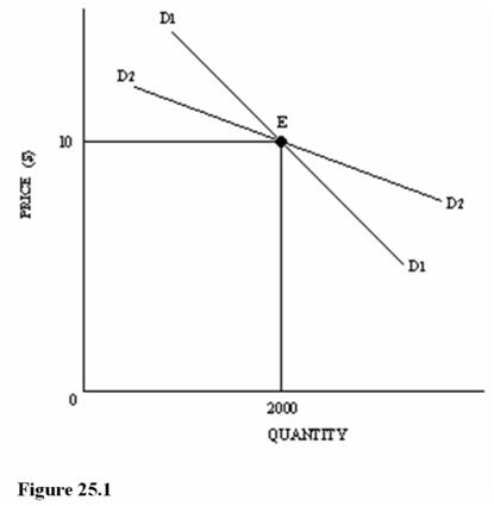A) Causes oligopoly profits to increase.
B) Causes U.S. cartels to become even stronger.
C) Reduces the barriers to entry into U.S. markets.
D) Creates an environment conducive to predatory pricing.
Correct Answer

verified
Correct Answer
verified
Multiple Choice
 Refer to Figure 25.1 for an oligopoly firm.Assume that the existing price and quantity are $10 and 2,000 units.Which of the following statements is most likely correct?
Refer to Figure 25.1 for an oligopoly firm.Assume that the existing price and quantity are $10 and 2,000 units.Which of the following statements is most likely correct?
A) Demand curves D1 and D2 both assume that rivals will not match any price changes.
B) Demand curves D1 and D2 both assume that rivals match any price changes.
C) Demand curve D1 assumes that rivals do not match price changes.
D) Demand curve D2 assumes that rivals do not match price changes.
Correct Answer

verified
Correct Answer
verified
Multiple Choice
A firm cannot maintain above-normal profits over the long run
A) Without the existence of a cartel.
B) Unless barriers to entry exist.
C) Unless predatory pricing occurs.
D) Without retaliation occurring.
Correct Answer

verified
Correct Answer
verified
Multiple Choice
If oligopolists start cutting prices to capture a larger market share, the result will be
A) Lower prices, decreased output, and larger profits.
B) Higher prices, increased output, and larger profits.
C) Lower prices, increased output, and larger profits.
D) Lower prices, increased output, and smaller profits.
Correct Answer

verified
Correct Answer
verified
Multiple Choice
Temporary price reductions intended to drive out competition are referred to as
A) Predatory pricing.
B) Price-fixing.
C) Price leadership.
D) Retaliation.
Correct Answer

verified
Correct Answer
verified
Multiple Choice
Market power leads to market failure when it results in
A) Decreased market output.
B) Lower market prices.
C) Normal economic profits.
D) The demise of the industry.
Correct Answer

verified
Correct Answer
verified
Multiple Choice
Market power is the ability of a firm to
A) Advertise.
B) Act as a price taker.
C) Control the price and quantity supplied.
D) Increase the number of substitute goods.
Correct Answer

verified
Correct Answer
verified
Multiple Choice
Concentration ratios tend to overstate the power of some corporations to influence economic outcomes because they measure output
A) For single firms rather than markets.
B) For the whole United States, which is too large a geographic market for some firms or industries.
C) Only for domestic production when the true market boundaries are international for some markets.
D) Over many industries rather than a single market.
Correct Answer

verified
Correct Answer
verified
True/False
Market share is the percentage of total output produced by a single firm.
Correct Answer

verified
Correct Answer
verified
True/False
The kinked demand curve demonstrates that if an oligopolist raises its prices, it is likely to gain market share.
Correct Answer

verified
Correct Answer
verified
Multiple Choice
RC Cola lost market share in the 1980s due to
A) Its decision not to advertise.
B) Consumers not liking the taste of its colas.
C) Wasting precious resources on advertising.
D) Its lack of shelf space at supermarkets.
Correct Answer

verified
Correct Answer
verified
Multiple Choice
In an effort to maximize profits, oligopolists could participate in all of the following but
A) Price leadership.
B) Price-fixing.
C) Cartels.
D) Self-destructive behavior.
Correct Answer

verified
Correct Answer
verified
Multiple Choice
Sky-High Skywriters raises its price, and the other four firms in the industry raise their prices in response.Coordination in this industry is accomplished by
A) Predatory pricing.
B) Price leadership.
C) Price-fixing.
D) Retaliation.
Correct Answer

verified
Correct Answer
verified
True/False
In an oligopolistic market structure, other firms will not notice if one firm experiences increased sales.
Correct Answer

verified
Correct Answer
verified
Multiple Choice
According to "Coke and Pepsi May Call Off Pricing Battle," price discounting (price wars) can destroy oligopoly profits.When profit destruction occurs,
A) Firms are powerless to change prices.
B) Firms will wait for one firm to increase prices.
C) Rival oligopolists seek to end it as quickly as possible.
D) The entire industry will always collapse.
Correct Answer

verified
Correct Answer
verified
Multiple Choice
According to "OPEC Agrees to Maintain Its Oil Output Ceiling at 30 Million Barrels per Day," OPEC wants to behave like a monopoly, choosing a rate of industry output that maximizes total industry profit.The challenges for all cartels, OPEC in particular, include all of the following except
A) Preventing some members from decreasing production.
B) Allocating market share.
C) Coordination.
D) Replicating monopoly outcomes.
Correct Answer

verified
Correct Answer
verified
Multiple Choice
A kinked demand curve indicates that rival oligopolists match all
A) Increased advertising.
B) Advertising reductions.
C) Price increases.
D) Price reductions.
Correct Answer

verified
Correct Answer
verified
Multiple Choice
If an oligopoly market is contestable and new firms enter, the
A) Market power of the former oligopolists will be reduced.
B) Number of firms in the industry will decrease.
C) Former oligopolists will raise their prices.
D) Profitability of the industry will increase.
Correct Answer

verified
Correct Answer
verified
Multiple Choice
In which of the following market structures are entry barriers the highest?
A) Perfect competition.
B) Monopolistic competition.
C) Oligopoly.
D) Monopoly.
Correct Answer

verified
Correct Answer
verified
True/False
Oligopolists consider the possible responses of rivals when making decisions.
Correct Answer

verified
Correct Answer
verified
Showing 101 - 120 of 152
Related Exams